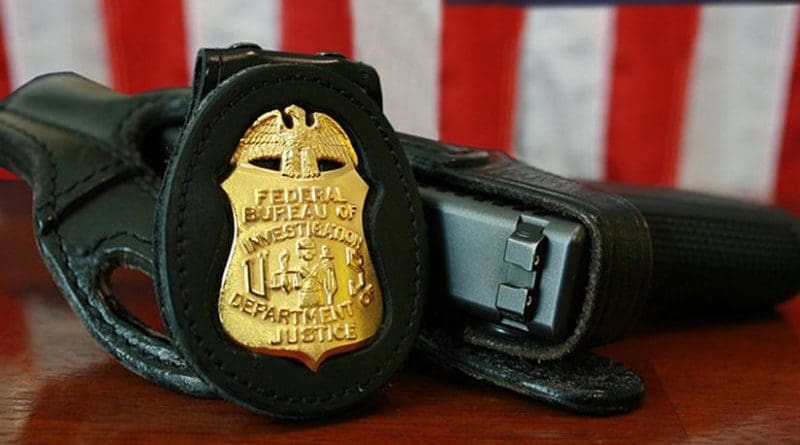The FBI Lurking Behind Every Corner – OpEd
The late Richard Masato Aoki, famed street fighting ’60s radical who armed San Francisco Bay Area Black Panthers, has been implicated as an FBI informant. Surprise, surprise.
The sight of armed Black Panthers prompted Governor Ronald Reagan to sign gun control in California. Aoki’s role in arming them has always had a special place in the state’s history. Now one wonders about the revelation’s significance in the FBI’s connection to Black Panther run-ins with the police.
The Bureau’s involvement should not surprise anyone familiar with its long record of infiltrating fringe political groups to disrupt them, entrap activists, elicit violence, and generally make trouble.
Then called the Bureau of Investigation, the agency early on became obsessed with powerless political extremists. It rounded up more than 50,000 alleged draft dodgers during World War I and was instrumental in the Palmer raids that detained thousands of radicals in 1919 and 1920 and deported over five hundred to Soviet Russia.
For decades, American presidents used the FBI to spy on political opponents—FDR targeted his critics and LBJ snooped on presidential challenger Barry Goldwater’s staff.
But the most infamous FBI program was COINTELPRO—the Bureau’s Counter Intelligence Program—that engaged in espionage of groups, both peaceful and violent, mostly left-wing but some right-wing, from 1956 to 1971, at the height of J. Edgar Hoover’s directorship. During this period, according to the journalist James Bovard, “Over 2,300 separate operations were carried out to incite street warfare between violent groups, to wreck marriages, to get people fired, to smear innocent people by portraying them as government informants, to sic the IRS on people, and to cripple or destroy left-wing, black, communist, or other organizations.”
COINTELPRO targeted the NAACP, the Congress of Racial Equality, Students for a Democratic Society, the Black Panthers, of course, and many others. Individuals subjected to FBI surveillance included Martin Luther King Jr., and Albert Einstein.
FBI operatives encouraged black radical groups to declare war on each other, tutored clueless draft protestors and right-wing paramilitary groups in the arts of burglarizing and vandalizing public buildings, established Ku Klux Klan organizations and personally assaulted Freedom Riders in premeditated beatings.
In the 1970s, COINTELPRO was shut down. The Senate’s Church Committee examined this program and found it blatantly abusive. Congress reined in the FBI a little. After 9/11, Attorney General John Ashcroft announced the unleashing of FBI intelligence gathering, implying that the agency had been restricted from mundane monitoring in ways it had not.
In the last decade, when the FBI wasn’t preoccupied with spying on the ACLU or Quakers, it has busied itself encouraging acts of “Islamic” terrorism. A staggering number of foiled terror plots have involved entrapment reminiscent of COINTELPRO. In Dallas, Washington, D.C., Chicago, New York, and Portland, FBI informants have goaded people into planning attacks that they likely would have never concocted on their own, in some cases supplying fake explosives, and swooping in at the last minute to save the day. The Bureau’s salad days are back.
In March 2010, amidst hysteria of a “rightwing extremism” epidemic, some progressives defended the FBI’s ensnaring Hutaree militia members in Michigan on charges of “seditious conspiracy” and plotting to overthrow the U.S. government with “weapons of mass destruction,” after the agency had infiltrated the group for over a year. A judge finally threw out the charges for insufficient evidence. They found no WMD, either.
On the other side of the spectrum, an FBI informant infiltrated an Occupy camp in Cleveland last October and convinced some fellow “anarchists” that they should blow up a bridge at Cuyahoga Valley National Park. The informant provided the C-4 explosives. Without a moment to spare, the FBI rushed in and foiled this plot. Whew.
The agency’s history has come full circle. It first emerged amidst popular fear of an anarchist threat to the republic. Anarchist writers had influenced President McKinley’s assassin, and President Teddy Roosevelt gave the issue top priority, declaring, “When compared with the suppression of anarchy, every other question sinks into insignificance.”
Despite concerns of such political violence—concerns that were arguably more legitimate a century ago than many fears that animate the FBI today—Congress resisted Teddy Roosevelt’s drive for a national police force, seeing it as a threat to the Constitution. New York Republican Congressman George Waldo predicted a “great blow to freedom if there should arise in this country any such great central secret service bureau as there is in Russia.” So President Roosevelt created the agency unilaterally, when Congress was in recess, putting it under Attorney General Joseph Bonaparte, great-nephew of Napoleon.
Amidst the communists, antiwar activists, unionists, states rights conservatives, Old Right opponents of the New Deal, black power groups, white power groups, New Left radicals, Muslim extremists, right-wing militia, and anarchist Occupiers, it seems the FBI has had its nose in every faction on the periphery of American politics, unnecessarily harassing peaceful groups as well as fabricating, exacerbating, or failing to stop real threats from antisocial elements.
Representative Waldo was prescient. With the FBI posing as dear friend, American law and order need no enemies.
This article originally appeared at The Huffington Post and is reprinted with permission.

